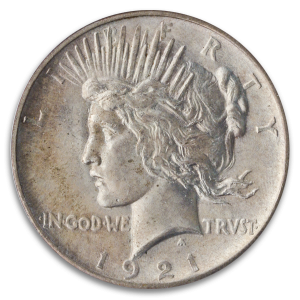The 1921 Peace Dollar
Posted on
The 1921 Peace Dollar has origins dating back to 1878 when Congress passed the Bland-Allison Act. This measure required the Treasury to make a monthly purchase of $2 million in silver for the sole purpose of converting the metal into silver dollars. These pieces carried the name Morgan Dollar because their design came from engraver George T. Morgan.
However, by 1918 World War I had wreaked havoc. In an attempt to destabilize the British, Germany began a deception campaign aimed at convincing the public that England was unable to sufficiently back their paper currency with silver. As a result, more people began to hoard silver. Prices increased which caused further troubles for Britain. America stepped in to help, selling England more than 270 million silver coins at $1 per ounce. In doing so, nearly half of the Morgan Dollars minted at that point were melted and shipped abroad.
Soon, the U.S. needed to strike new silver dollars in accordance with the Bland-Allison Act. Some suggested designing these new coins to commemorate the end of The Great War, later known as World War I. Charles Moore, the U.S. Commissioner of Fine Arts, and sculpture James Earle Fraser, convened with the mint director to organize a competition for the design of the new piece. A group of artists would be invited to submit designs with an award of $1,500 going to the winner.
However, when the plan for a Peace Dollar was introduced as a joint resolution it met with some resistance. Fortunately, advocates for the peace dollar were able to move forward with their plans because the Morgan dollar had been in production for over 25 meaning it was now officially subject to change per the provisions of the Bland-Allison Act.
The youngest of the designers at 34, Anthony de Francisci, won. His design took direct inspiration from his wife. Francisci used her profile as the basis for his rendering of Liberty.
Other aspects of his design drew harsh criticism. One side of the coin showed an eagle breaking a sword in a symbol of peace and end to war. Some thought the broken sword was too representative of someone who has disgraced themselves. These objections grew with the mint receiving a significant number of complaints. The complicated emotions surrounding World War I still loomed large and many Americans felt this image cast a deeply unfavorable image of the U.S. Eventually, the broken sword was removed from the design.
By January 3, 1922 the Peace Dollar was ready to enter circulation. Francisci himself purchased 50 coins, however, his motivation was not sentimental. According to the 2005 book Renaissance of American Coinage book author Roger W. Burdette explains that Francisci purchased to coins to settle bets he made that he would not win the competition.
By 1922 the Philadelphia, Denver, and San Francisco Mints struck a combined total of 84 million coins. The relief on the coins was so detailed and indelible that it eventually had to be reduced because the dies fractured under the pressure. Today, the coin is an enduring reminder of the power of peace and the talents of one designer who never imagined his design would be seen by so many.
At Blanchard and Company, we’re pleased to offer a wide variety of numismatic rarities. Our history gives us unparalleled expertise in helping collectors and investors find just what they’re looking for. Give us a call today at 800-880-4653 and let us put our 40+ years of experience to work for you.







